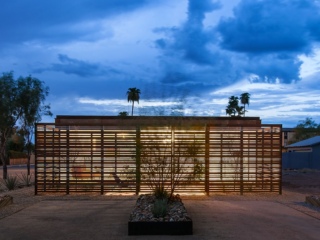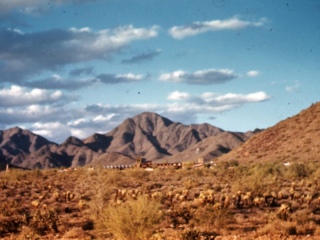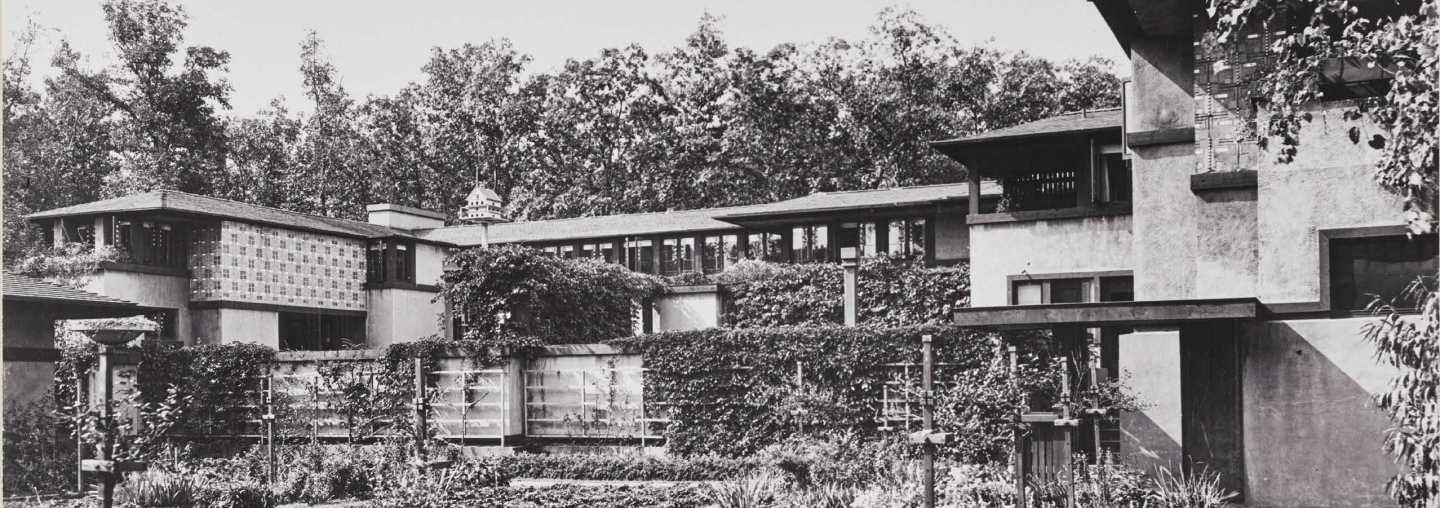
Teaching Gardens: The Sociology of Plants
Jennifer Gray | Mar 20, 2019
During Frank Lloyd Wright’s Fellowship, he emphasized the idea of learning by doing, especially when it came to experiences and direct connections to the natural world. He wanted his students to be well-rounded individuals, who had an understanding and connection to nature and the environment. Here Jennifer Gray delves into how Wright’s students learned from nature.
In 1932, during the depths of the Great Depression, Frank Lloyd Wright founded a “school of the soil,” the Taliesin Fellowship, on two hundred acres of farmland near Spring Green, Wisconsin, the ancestral valley of his family, the Lloyd Joneses. Wright was insistent that the curriculum not center on books and lectures but rather prioritize hands-on experiences and direct connections to the natural world. Students felled trees and sawed them into lumber, quarried rock and burned lime, dug ditches, labored in the fields, and planted and harvested food. 1 The Fellowship was, in some ways, the realization of ideas Wright had already expressed in written form, most notably in The Disappearing City. This text, written at the same time Wright founded his school, advances an ideal about society based on individual homesteads that enabled citizens to farm their own land. The resulting redistribution of wealth and self-sufficiency, Wright argued, would foster a more democratic social order. Schools in this utopia would be parks, located in the choicest parts of the countryside, with enough land to provide individual gardens and vegetable beds to every child. In these teaching gardens, according to Wright, “…children would be working, preparing food and learning how to eat it, learning to see accurately by drawing what he sees…learn how to grow two blades of grass where one or none grew before.”
“Each pupil,” he argued, “would learn of the soil by working on it and in it.” 2 Such practical programs for engaging the land have been, for the most part, overlooked in histories on Wright and nature; however, I would like to unpack them in the hopes of expanding our understanding of Wright’s relationship to nature and also raising questions relevant to our own time, as we continue to struggle with both environmental degradation and equal access to quality education, probably the most important pillar of a democratic society.

Apprentices working at the Taliesin fellowship complex.
As a child, Wright was educated according to the principles of Friedrich Froebel, a pioneer of hands-on learning and the inventor of kindergarten, after his mother encountered a kindergarten exhibit at the 1876 Centennial Exposition in Philadelphia. 3 Froebel’s curriculum centered on a sequence of active-learning exercises using materials he called “gifts”—worsted balls, geometric shapes, assemblies of wooden blocks, and tablets of patterns, just to name a few—which educated children about the world around them (color, texture, shapes, etc.) through hands-on play. The emphasis on geometry speaks to Froebel’s belief in the uniformity and unity of nature’s laws, which he apprehended while studying the natural sciences, particularly rock crystals, and while working as a forester. 4 Much has been written about the impact Froebel blocks had on Wright and the geometric abstraction of his architecture, but what I want to emphasize is that Froebel’s abstract concepts originated in his study of terrestrial nature—actual rocks and trees. Indeed the word kindergarten literally means children in or children from the garden, suggesting that perhaps studying animals, grass, and trees might be a point of departure for an expanded understanding of how nature and learning intersected in Wright’s practice.
One of Wright’s earliest commissions was to design a school building for his aunts, Ellen and Jane Lloyd Jones, who in 1887 had founded a progressive educational center called The Hillside Home School near Spring Green. Hillside was a coeducational “home, farm, and industrial” school deliberately sited in the countryside to provide opportunities for children to learn directly from nature. Its teaching methods advanced what was called, at the time, the “New Education,” an approach that emphasized hands-on experimentation (learn by doing) rather than conventional curriculums based on memorization. “Nature Study” was a core component of learning at Hillside. Students embarked on long excursions into the countryside in order to study plants, animals, soil, and rocks in situ, in their natural environments. They collected specimens, such as shells, minerals, and fossils, which were subsequently mounted and classified in consultation with an expert in natural sciences. Bird watching was a particular focus of the course, and the school held a comprehensive collection of species from the region. 5 This kind of active learning—direct observation from nature, fieldwork, and classification—complemented experiments conducted in the well-equipped laboratory, itself another site for hands-on learning. In the annual prospectus for Hillside, the Lloyd Jones sisters emphasized the importance of locating the school in the country: “…the farm is a great laboratory which will make clear and interesting the study of the sciences.” 6 In other words, when children directly engaged with rocks, birds, plants, and so forth, they were laying the foundations for future study of formal disciplines, such as zoology, agriculture, geology,
and botany.
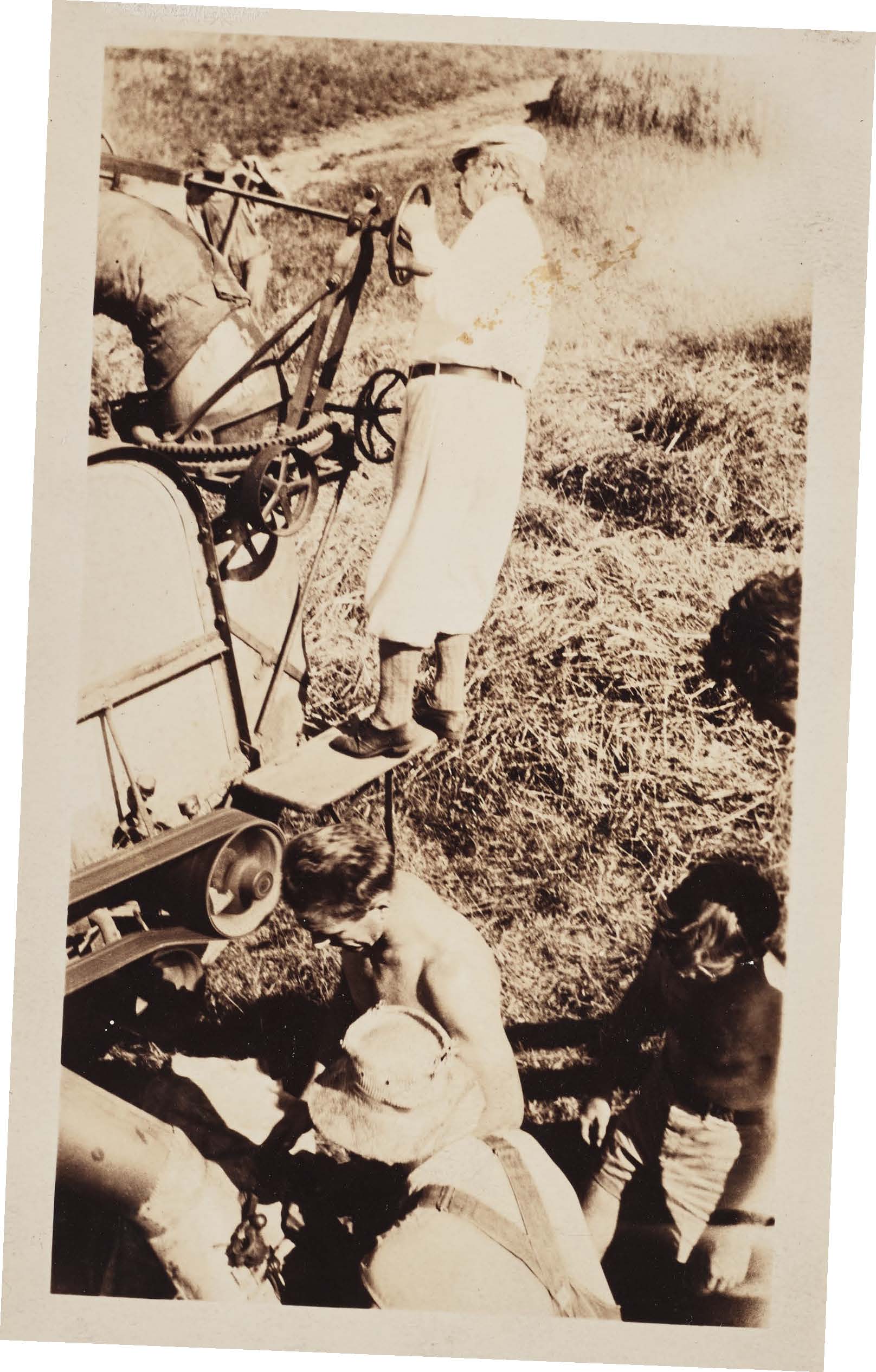
Frank Lloyd Wright harvesting
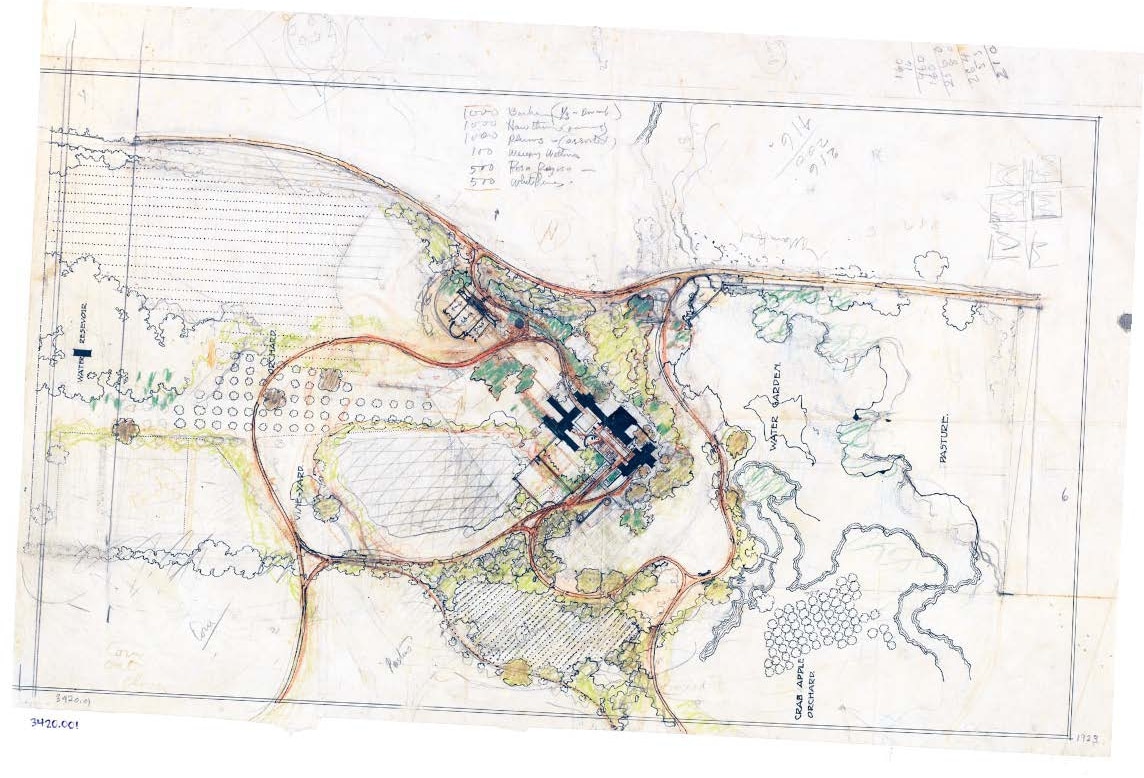
Taliesin Fellowship complex begun in 1932-33. Site plan.
The idea of a school that united home, farm, and industry was an attempt to recuperate some of the values of preindustrial social relations; it must be understood as a critique of laissez-faire capitalism and the social inequality and fragmentation it produced. John Dewey, a pioneering educational reformer and author of Democracy and Education (1916), was one of the first to sound the alarm about the threat industrialization posed to both education and democracy. 7 School curriculums based on rote memorization only rehearsed the monotonous and unskilled labor performed in factories; moreover, the practice of “tracking” students into manual training, domestic science, or college prep courses of study reproduced class hierarchies and gender biases. Working class children were overwhelmingly tracked into vocational programs and girls into home economics, while affluent male students tracked into universities. School “systems” naturalized these inequalities. As Wright excoriated, “…children grow up, herded by thousands into schools built like factories, run like factories, systematically turning out herd-struck morons as machinery turns out shoes.” 8
At Hillside and other schools like it, including Dewey’s own Laboratory School founded in 1896 at the University of Chicago, hands-on learning reunited practice and theory. Students readily learned physics when their first model barn collapsed; growing vegetables introduced questions about climate, geography, and agriculture, and when students cooked them, they learned about chemistry. Such an integrated curriculum taught a respect for manual labor as the foundation of abstract knowledge. It taught social cooperation, since children often worked in groups and the interconnections between courses of study were unavoidable. And it taught children environmental responsibility, as nature—the very soil, plants, and animals—was understood to be the basis of abstract knowledge, such as physics, biology, and chemistry, but also the very source of human life, quite literally in the sense of growing food, caring for animals, and so forth. As Wright surmised, “The farmer is essentially food for humanity. It is his job to feed the cities. And the raw material for clothing is his job too. Without the farmer the cities would starve and go naked.” 9
Financial hardships forced Hillside Home School to close in 1915, but Wright’s aunts urged him to continue its mission, and Wright set about raising funds for his own school of the soil. In 1927 he solicited money from colleagues, such as the landscape architect and pioneering ecologist Jens Jensen, and from clients, such as Queene Coonley, an avid horticulturalist for whom Wright had designed a kindergarten in 1911 that originally incorporated teaching gardens, small individual plots for each child to cultivate. 10 Wright published and distributed a prospectus outlining the curriculum and goals of his school that reached, among others, John Dewey, who declined to donate money despite claiming sympathy with the school’s aims. For a period of time, Wright courted a partnership with the University of Wisconsin, where another of his clients, Franz Aust, was on the faculty as professor of landscape architecture. In 1932, after all these options failed, Wright forged ahead and founded the Taliesin Fellowship on the very grounds where Hillside stood.
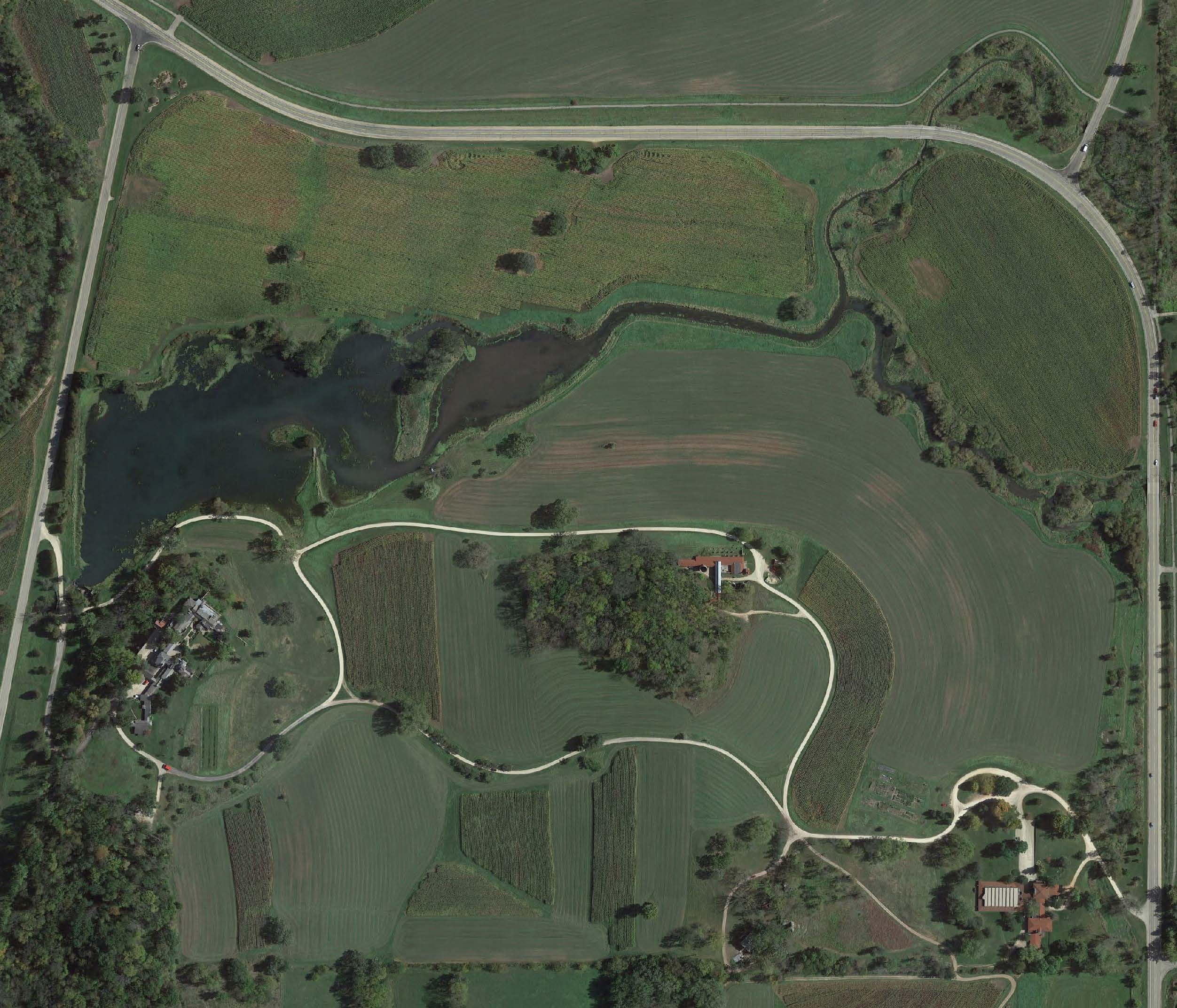
Taliesin in Spring Green, Wisconsin. Map Data: Google Earth
Today, nature is still at the center of Taliesin. Contour farming and sustainable, local food production informs the agricultural practices, and ultimately the menu, at the site. As Wright described it, “the Taliesin Fellowship is a preparation for a better way of life.” 11 Wright’s school was a community that, more than many institutions of its time, tolerated differences in race, gender, sexual orientation, and politics; apprentices were individuals but they also had to work together. As one visitor marveled in 1933, the apprentices “work the fields and gardens, build and maintain the roads, the water, power and heating systems; they do their kitchen work and tend their rooms, build their own furniture and whole interiors.” 12
The takeaway is that Wright aspired to build a community, not just a school. In this endeavor, one that perhaps offers a model for overcoming our contemporary crises in both education and the environment, nature again offers a useful object lesson. During the same years that Hillside was founded, gardeners and botanists, notably Wright’s friend and colleague, Jens Jensen, started to advance theories that understood nature in ecological terms—namely that plants and animals do not live as isolated, individual organisms but, rather, that they coexist in mutually dependent, symbiotic communities. 13 Tellingly, the original term for ecology was “plant sociology,” and it became a widespread metaphor at the turn of the 20th century for rethinking social relations along more equalitarian and holistic terms—a human ecology—that was based on cooperation and valued the contributions of all its members. In this regard, it seems we still have something to learn from Wright and from nature.
This article originally appeared in the spring 2018 issue of the Frank Lloyd Wright Quarterly magazine, “Out of the Ground.”
ABOUT THE AUTHOR
Jennifer Gray is Curator of Drawings and Fine Arts Library, Columbia University, where she also teaches. She studies modern architecture, with an emphasis on how designers and activists used architecture, cities, and landscapes to advance social and spatial justice at the turn of the 20th century. She recently curated two exhibitions on Frank Lloyd Wright, including “Frank Lloyd Wright at 150: Unpacking the Archive” at the Museum of Modern Art in New York. Her work has been published in journals of architectural history and critical preservation, and she is developing a book project on the Chicago architect Dwight Perkins.
1“The Taliesin Fellowship,” typescript (n.d.), The Frank Lloyd Wright Foundation Archives (Avery Architectural & Fine Arts Library, Columbia University/The Museum of Modern Art), 1008.003. 2 Frank Lloyd Wright, The Disappearing City (New York: William Farquhar Payson, 1932), 79-80. 3 Frank Lloyd Wright, A Testament (New York: Horizon Press, 1957), 19-20. 4 Richard MacCormac, “Form and Philosophy: Froebel’s Kindergarten Training and Wright’s Early Work,” On and By Frank Lloyd Wright: A Primer of Architectural Principles, ed. Robert McCarter (London: Phaidon, 2005), 124-25. 5 Ellen and Jane Lloyd Jones, prospectus for The Hillside Homeschool (1910), Wisconsin Historical Society, 5-9. 6 Ibid., 5. 7 See John Dewey, “The School and Society,” (1900); rev. ed. 1915, 1943; reprinted as combined edition with “The Child and the Curriculum” with introduction by Leonard Carmichael. (Chicago: University of Chicago Press, 1956.) 8 Disappearing City, 3. 9 Ibid., 64. 10 A more modest version, known as the Coonley Playhouse, was constructed in 1912. 11 “The Taliesin Fellowship,” 1008.003 12 “Hans Koch, “Taliesin and Its Master,” typescript (1933), The Frank Lloyd Wright Foundation Archives (Avery Architectural & Fine Arts Library, Columbia University/The Museum of Modern Art), 1008.040 13 Robert E. Grese, Jens Jensen: Maker of Natural Parks and Gardens (Baltimore and London: Johns Hopkins University Press, 1992), 52.

